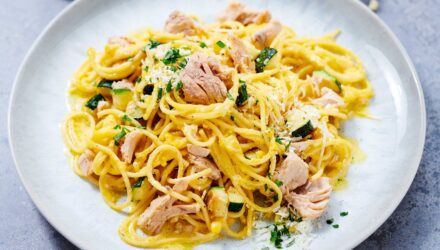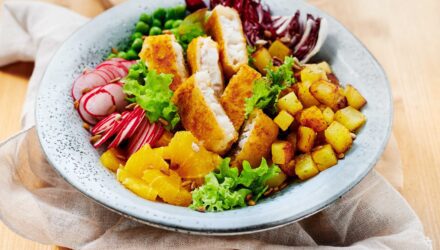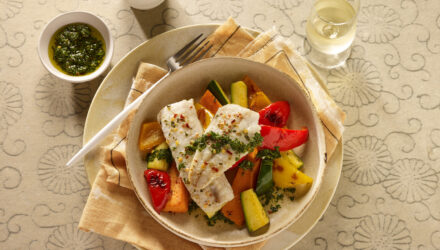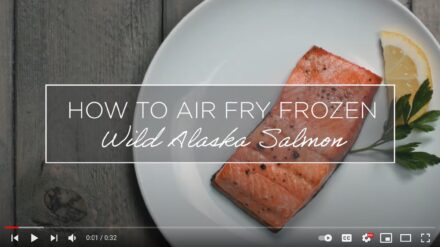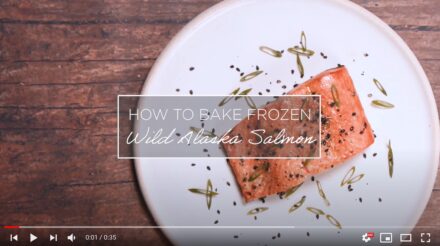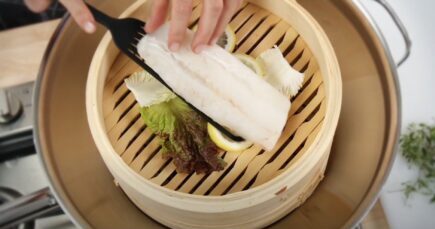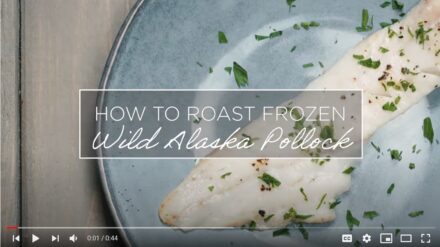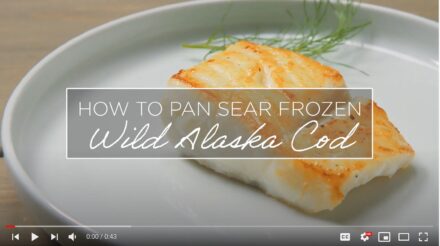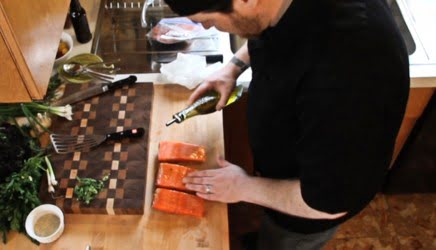COOK IT FROZEN!®

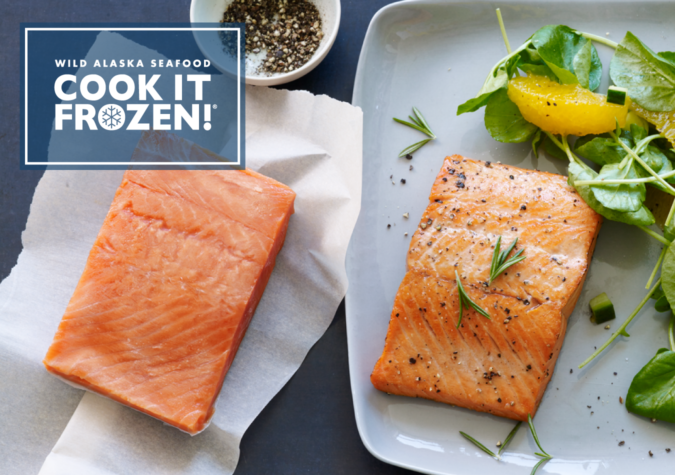
Mealtime in Minutes, No Need to Thaw
Delicious heart-healthy meals can be on your table in as little as 15 minutes using our COOK IT FROZEN!® techniques – no thawing necessary!
With these simple, timesaving how-to videos, you can have healthy meals in minutes, cooking directly from frozen, using familiar methods like pan searing, baking, grilling and pressure-cooking.
A Fresh Look at Frozen
Wild Alaska seafood is harvested at the peak of freshness, in harmony with each species’ natural life cycle, ensuring the health of future fish stocks. Most Alaska seafood is frozen within hours of harvest using advanced freezing technologies such as cryogenic blast freezing and glazing to lock in that just-caught flavor, abundant nutrients and premium quality for year-round enjoyment.
Frozen Alaska seafood portions can be quickly and easily prepared without thawing. In about 15 minutes you can go from frozen to fabulous, using this simple COOK IT FROZEN!® technique:
- Heat a heavy nonstick skillet or ridged stovetop grill pan over medium-high heat.
- Brush both sides of frozen fish with olive, canola, peanut or grapeseed oil.
- Place fish in heated pan and cook, uncovered, about 3 minutes, until browned.
- Turn fish over, season with spices, and cover the skillet tightly.
- Reduce heat to medium, and cook 6 to 8 minutes more until opaque throughout.
Quick Tips
- Equip Yourself with the Right Equipment: For stovetop grilling and sautéing, use a heavy nonstick skillet or ridged stovetop grill pan.
- Test the Temperature: Pans, grill and broiler/oven must be hot (around 400ºF) before you start cooking. To test the temperature of a stovetop pan, sprinkle a few drops of water on the skillet; if they immediately pop off the surface, the pan is ready.
- Check the Oil: Using a pastry brush, lightly brush frozen fish with olive, canola, peanut, grapeseed, soy or safflower oil. These oils work best for high-heat cooking. (Do not use butter, sunflower or corn oil, as they will burn at high heat.)
- Spare the Spices: When sautéing or stovetop grilling, avoid seasoning the fish with dry spices before it is placed in the pan. (Since the pan is very hot, the spices will burn and stick to the pan.) It is best to season seafood after you flip it.
Cooking from Frozen Techniques
-
Bake/Roast
-
Wild Alaska Pollock Instructions
- Preheat oven to 400ºF.
- Rinse Alaska pollock under cold water; pat dry with a paper towel.
- Brush top of fillet with high oleic vegetable oil (olive, canola, peanut, grapeseed, soy or safflower). Avoid butter, sunflower or corn oil as these will burn at high heat.
- Place on spray-coated wire rack on baking pan, or foil-lined baking sheet.
- Cook for 5 minutes on middle rack.
- Season and cook additional 3-5 minutes.
- When finished, Alaska pollock should be opaque throughout and flake easily with a fork.
Wild Alaska Salmon Instructions
- Preheat oven to 450ºF.
- Remove salmon from vacuum sealed bag and rinse under cold water; pat dry with a paper towel.
- Brush both sides with high oleic vegetable oil (olive, canola, peanut, grapeseed, soy or safflower). Avoid butter, sunflower or corn oil as these will burn at high heat.
- Place on spray-coated pan or foil-lined baking sheet.
- Cook 4 minutes on middle rack.
- Season and bake 10-13 additional minutes. Flip only thick portions.
- When finished, salmon should be opaque throughout and flake easily with a fork.
Cooking Technique Videos
-
Poach
-
Instructions
- Remove halibut from vacuum sealed bag and rinse under cold water; pat dry with a paper towel.
- Add herbs, seasoning, and citrus or aromatic veggies to a large pan and fill with water.
- Set to medium heat and bring to a gentle simmer.
- Add halibut to the liquid and cook, covered, for 4-5 minutes.
- Turn off heat and allow to rest in liquid another 5 minutes.
- When finished, halibut should be opaque throughout and flake easily with a fork.
Cooking Technique Video
Try This Recipe -
Air Fry
-
Instructions
- Remove salmon from vacuum sealed bag and rinse under cold water; pat dry with a paper towel.
- Brush both sides of fillet with high oleic vegetable oil (olive, canola, peanut, grapeseed, soy or safflower).
- Season top.
- Place on fryer rack and close.
- Cook 8-10 minutes on 390-400ºF.
- When finished, salmon should be opaque throughout and flake easily with a fork.
Cooking Technique Video
Try This Recipe -
Pan Sear
-
Instructions
- Remove cod from vacuum sealed bag and rinse under cold water; pat dry with a paper towel.
- Brush both sides of fillet with high oleic vegetable oil (olive, canola, peanut, grapeseed, soy or safflower).
- Heat a heavy-bottomed/non-stick pan over medium-high heat.
- Place cod in heated pan.
- Cook uncovered, 3-4 minutes, until bottom is lightly browned.
- Flip; season fish.
- Reduce heat to medium and cook covered, 5-6 minutes.
- When finished, cod should be opaque throughout and flake easily with a fork.
Cooking Technique Videos
-
Grill
-
Instructions
- Heat grill to 400ºF.
- Remove salmon from vacuum sealed bag and rinse under cold water; pat dry with a paper towel.
- Tear an 18-inch wide sheet of foil so it is 4-inches longer than the fillet.
- Spray-coat the dull side of foil and place salmon on the foil, skin-side down.
- Brush top with high oleic vegetable oil (olive, canola, peanut, grapeseed, soy or safflower). Avoid butter, sunflower or corn oil as these will burn at high heat.
- Bring sides of foil together and fold over several times to seal; roll up ends to form a packet.
- Place on grill seam-side down, and cook 8-10 minutes.
- Remove from grill; open and season.
- Crimp foil loosely to close and return to grill, seam-side up.
- Cook an additional 8-10 minutes. May take up to 12 minutes for thicker portions.
- When finished, salmon should be opaque throughout and flake easily with a fork.
Cooking Technique Video
Try This Recipe -
Instant Pot
-
Instructions
- Remove salmon from vacuum sealed bag and rinse under cold water; pat dry with a paper towel.
- Add 1 3/4 cups water into the pot. Place salmon on steamer rack and lower into pot.
- Season.
- Turn pressure valve to ‘sealing.’ Cook 3 minutes on high pressure.
- Immediately turn pressure valve to ‘venting’ to release and remove lid once pin drops.
- When finished, salmon should be opaque throughout and flake easily with a fork.
Cooking Technique Video
Try This Recipe

